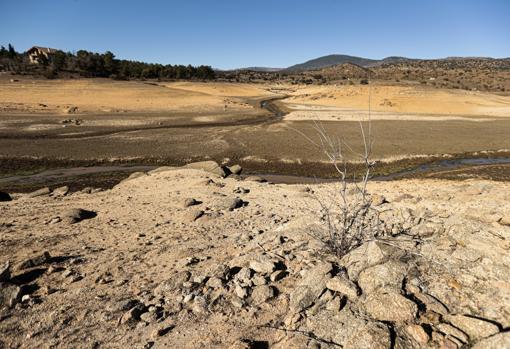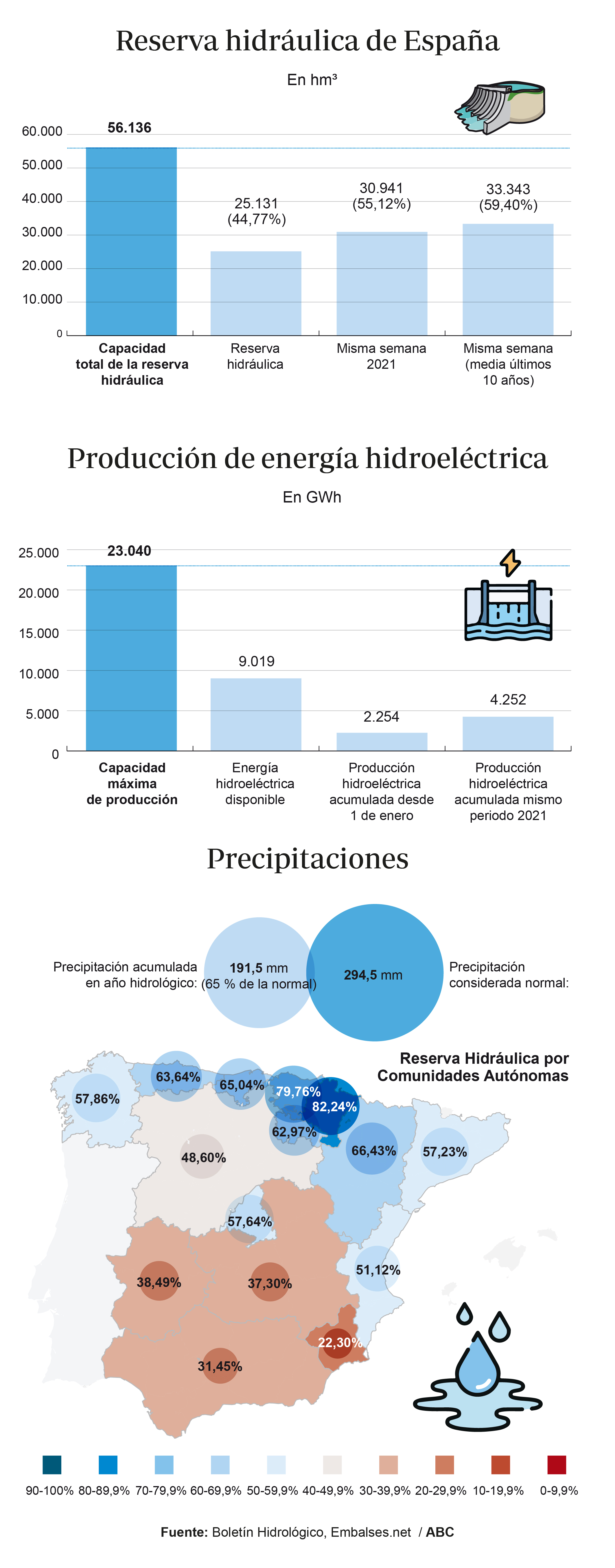The Spanish countryside is drying up. From last October 1 – when the hydrological year began – until yesterday it has rained a third less than what was usual in an already dry Spain. Meteorologists do not foresee rains in the medium term. There is an anticyclonic block that does not look like it will change, and this situation has surprised us with hardly any water reserves. The reservoirs are at 44.7 percent of their capacity, well below what they could be at this time, when they usually reach 60 percent. Consequently, so far this year half of the hydroelectric energy has been produced than in the same period of the year
previous.
The first to sound the alert have been the people of the countryside: the farmers, who see their crops in danger, and the ranchers, especially the extensive ones, who have nothing to eat in the dry forest. The agri-food sector contributed 2020% of GDP in 9,7. But the water shortage, if it persists, will also affect other essential productive sectors, such as tourism, construction, industry and electricity production. Water is at the foundation of the productive system and its scarcity can put the economic recovery after the pandemic at risk.
 The El Buerguillo reservoir, in the image, is located near the towns of El Tiemblo and Cebreros – Jaime García
The El Buerguillo reservoir, in the image, is located near the towns of El Tiemblo and Cebreros – Jaime García
Drying is common in Spain, but this time a country is extremely tense due to Covid, the economic crisis and the sudden exorbitation of prices. The water break also aggravated political tension and led to clashes between the regions.

reservoirs
To deal with cyclical droughts, Spain has been building dams and reservoirs that store water in times of rain to use it later in times of scarcity. The Romans already resorted to this technique when in the 1.200st century BC they built the Proserpina reservoir in Badajoz, the oldest in Spain. There are now more than 650 dams and reservoirs. More than half –about 40– were built during the Franco era, but in the 300 years of democracy nearly 85 have been inaugurated. And new ones continue to be built, such as the one in Mularroya (Zaragoza) or the one in San Pedro Manrique (Soria). ), although the Government of Pedro Sánchez has suppressed 27 reservoirs –which were previously projected– in the new hydrological plans, which will be debated next summer. There are also inexplicable situations, such as the Villagatón reservoir (León), which has been built for XNUMX years and has not yet been put into service. In fact, it's still empty.
The lack of rain affects much of the Iberian Peninsula. Only Navarra, the Basque Country, Cantabria, Aragón, La Rioja and Asturias are saved. The worst is Murcia, Andalusia, Extremadura and Castilla-La Mancha. Also in Catalonia the drought is beginning to be worrying. There are 22 Catalan municipalities that have been suffering restrictions since last October and have a habit of increasing the production of desalination plants from 20 to 85 percent to stop the decline in reserves. Since they were produced to collect records, in 1914, there had not been a year as dry in Barcelona as 2021, and so far in 2022 the trend has not changed. But the most alarming situation remains in the middle. In some Extremaduran municipalities there are water restrictions and it has been forbidden to wash cars, look at gardens or flush streets.
Forest fires have been registered in several areas of the peninsula, which concern the extreme dryness of the land, and Castilla y León has prohibited the burning of stubble these days.
“A large part of the grain harvest is going to be lost. And the cattle cannot eat because the mountain is dry. We are very concerned about the viability of both agricultural and livestock farms”, warns Juan Pedro Miravete, a farmer from Almería
"A large part of the cereal harvest is going to be lost," warns Juan Pedro Miravete, a farmer from Almería. "And the cattle can't feed themselves because the forest is literally dry," he adds. “We are very concerned about the viability of both agricultural and livestock farms. It's been many weeks now that not a single drop of water has fallen,” says Andrés Góngora, secretary of the Coordinator of Farmers and Ranchers of Almería. This same concern extends to Extremadura, according to what Natalia García-Camacho, president of the Professional Association of Farmers and Ranchers of Don Benito and Comarca, informs ABC. “The sector is very touched. Even before the pandemic, we protested because we did not receive fair prices for our products. We need our products to cover our costs and to be able to live from our work.” But, since then, the situation has worsened: "The price of fertilizers, phytosanitary products, animal feed, diesel, metals for tools has risen... And, now, added to all this is the uncertainty due to the drought", he explained. For all these reasons, "as soon as the Drought Table is convened so that the exceptional rules for the use of water resources for irrigation and irrigation are available."
Forecast without exchange
Although meteorologists are very cautious in long-term forecasts, they do not expect the situation to change. "The prospects are not good," says José Miguel Viñas, Meteored's meteorologist. “To make a long-term forecast, of weeks or months, we have different tools than those of a conventional forecast for the next few days,” he explained. “For the long term, models and statistical data are used to anticipate a behavioral trend. And what the trend models are telling us is that this same weather pattern, with a clear dominance of high pressures, will last throughout February. Including, the seasonal forecasts mark a similar beginning of spring”.
That does not mean that it will not rain at any time, because, according to Viñas, “these trends mark a certain normality in the Mediterranean area and the eastern half of the peninsula. But it is not a particularly rainy time there. What seems clear is that even if there is some episode of rain, the dynamic that we have been seeing since the beginning of the year will not be broken.
“The key is in the spring rains”
Responsible for the lack of rain is the Azores anticyclone. «The anticyclone that only dominates in the new space, that of the Azores, sometimes strengthens, as is happening now, and practically remains immobile in a position whose center can oscillate between the north of the peninsula, France, the British Isles or the netherlands. While it is there, all the storms that form in the Atlantic go north (Scandinavia) or south (the Canary Islands)”. The key is in the spring rains, he explains, "because in March and, above all, April and May, there will have to be precipitation, but it will be necessary to see if the bloco is giving way or if we have a dry spring."
